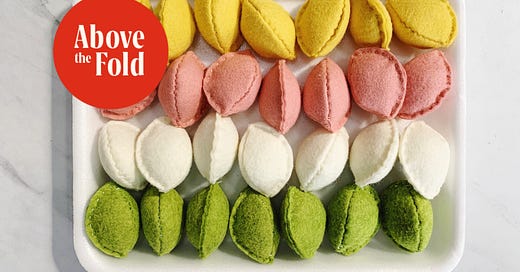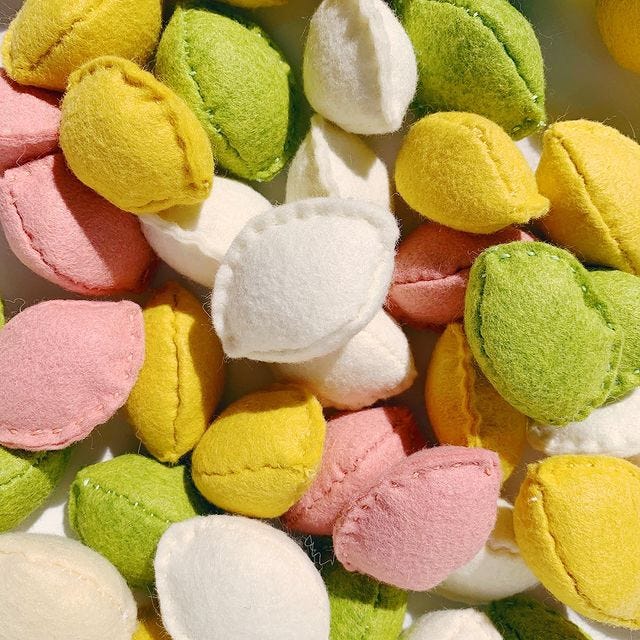Interview #8: Christine Jee's Felt Dumplings
How Dumpling Mart's hand-sewn creations are inspiring dumpling imaginations of all ages.
Welcome to Above the Fold, a free newsletter all about dumplings and the people who make them. Like what you see? Subscribe and it’ll come straight to your inbox every other Wednesday (and sometimes, like this month, every Wednesday!).
By day, Christine Jee is an arts educator with a focus on elementary-age kids. On the side, she’s the entrepreneur behind Dumpling Mart, a small business—and Etsy shop—specializing in dumplings, rice cakes, and soup dumplings rendered hyper-realistically in felt.
Christine’s felt dumplings were originally created to diversify the imaginative play options available to young ones like her daughter; since then, they’ve found an equally fervent fan base with non-kids (as I write this, I’m gazing fondly at my own limited-edition pack of “fried” dumplings coated in iridescent gold fabric paint).
It’s rainbow dumpling month at Above the Fold, and Christine also shares her connection to songpyeon, colorful stuffed Korean rice cakes traditionally consumed during Cheusok, the Korean harvest festival that starts on September 21.
While Christine’s felt songpyeon aren’t currently for sale, she’s raffling off 1 pack until 8 pm EST today—to enter, donate any amount to No Kid Hungry through the fundraiser link on this post (note: the fundraiser link will only show up via mobile device).
In her words below, learn about Christine’s own dumpling memories, the mission behind Dumpling Mart, and her experiences celebrating Cheusok with her family.
There's a lot of formative dumpling memories for me, growing up as a first-generation Korean-American. I have a very vivid memory of walking into my grandmother’s house and seeing just trays and trays of dumplings for Lunar New Year, for example. When I was very young, before I could even fold and help stuff them, I would sit at the table and be in charge of layering the dumpling wrappers onto a cutting board and brushing them with water so that she could fill them and fold them.
In the winter in Massachusetts, my mom would plop big dumplings into bowls of soup. In the summer, we would get fresh chives from our garden and have cooled, boiled dumplings rinsed off with cold water. I’d bring them to school—my mom would fry up a big pile of fried dumplings for cultural days or things like that.
Both of my grandmothers, aunt, and mom all made their living through sewing—my maternal grandmother's business was called "Handy Granny"—for quite a while. Even my dad has always been good with his hands. So growing up, I always saw the people around me roll their sleeves up and noticed how satisfying it could be to make things yourself.
I started sewing my felt dumplings about eight years ago. I have a nine-year-old now, and she was about a year old at the time. She had gotten a toy kitchen for her birthday, or something like that, and I was disappointed by the play food options that were available. There's so many cute things that you can get, like little pots and pans, but I saw a lack of representation of our Korean-American culture.
I felt that I had to take matters into my own hands and expose her to more than just pizzas and hamburgers in her imaginative play and in her real-life palate. Over the years, I've made these felt dumplings and some other things, like felt kimbap, as gifts for people—and they would always tell me that I should sell them. And so I eventually did at the end of 2019. During the pandemic, I've had a lot more time to work on it, as well.
The unexpected part of making these dumplings and actually selling them is having a wider audience and seeing who's buying them and what are they using them for. Because it's not just for kids—there's a lot of adults who have this connection to dumplings. Reading the messages that people write when they send my dumplings as gifts is really sweet. Someone had gotten in touch with me and wanted to propose to his girlfriend using one of my dumplings and the little steamer baskets that they come with. That was a fun, creative challenge for me.
This project has led me to examine my own life as part of the diaspora, what it means to grow up as a first-generation Korean-American. But also as a parent, what is it that I want to pass down to my daughter?
I think like many other Asian-Americans, sometimes I feel like I'm not truly Asian, I'm not truly American. But then as a daughter of immigrants, it's important for me to make sure that my daughter grows up with a strong sense of her heritage. I think we owe it to our kids and to those who came before us to make sure that we hold onto our culture and take pride in it, but also make things our own.
People send me pictures all the time, and it's fun to see all the different kinds of kids who are playing with dumplings. There was a little boy who was playing with his toy dinosaurs, and they were eating dumplings. It's important for kids to have a wide range of toys and imaginative play. If this is how kids are growing up with these kind of experiences and this kind of exposure, I'm excited to see what the future will bring for the kind of foods that these children might eat or what they would be open-minded towards.
Over the years, I've come up with different variations. The songpyeon, for example, is something else that's stuffed and filled. Songpyeon is like a rice cake. It’s chewy, made with short grain rice flour1, and filled with a sweet sesame paste. And you steam it on top of pine needles. I remember foraging for the pine needles in my backyard and making them with my mom—it's a memory that I hold near and dear to my heart.
I had the extra time due to the pandemic, and I needed a creative outlet. My parents moved to Korea a few years ago, and I had to text my mom pictures back and forth. I would send her videos, asking, “Do you think this looks right?"
I think a lot of Korean-Americans actually don't grow up celebrating Chuseok, and for a variety of reasons. We don't have the luxury of having time off from school and work to celebrate it, especially if it's in the middle of the week or something like that. But it was always important for my mom that we would celebrate Korean holidays.
This year, I am hoping I can make them from scratch with my daughter. I think she'll have fun. When I used to make them with my mom and my sister, my mom would tell us that there's a Korean saying that if you can make them beautifully and fold them beautifully, it's supposed to mean that you'll have beautiful children some day. She would always compliment me, and be like, "Oh, you do such a good job. You'll have such a beautiful daughter when you're older."
I think it does reflect the love and care that you put into other things, including how you raise your children. I take it not necessarily as physically beautiful, but hopefully my daughter has been seeing me making and selling and sharing my felt dumplings with other people. I hope she'll see a lot of details that I put into it and why this matters to me and will process this and make sense of it, and understand the culture and importance of dumplings, and also our Korean-American identity.
Plus: Mooncakes!
Cheusok is one of several Mid-Autumn celebrations happening throughout Asia on September 21. Earlier this month, The New York Times published an excellent piece on mooncakes by Clarissa Wei that explores the tradition and variations on the filled pastry traditionally consumed during this time.
The article links to a recipe from Betty Liu’s My Shanghai cookbook, and I’m not exaggerating when I say that Betty’s savory suzhou mooncakes are one of the best things I’ve ever baked at home, both in experience and finished product. The traditional laminating method, using an oil-enriched flour paste, results in a dough that not only rolls and shapes like a dream, it also remains shockingly flaky straight out of the fridge once baked. As someone who once made 100 pigs in a blanket in order to celebrate her 30th birthday, suffice it to say I ate my way through a dozen of these in 48 hours.
And to bring us back full circle to rainbow month, I’ll leave you with a link to this stunning double-rainbow mooncake being sold this year at The Lapis Place bakery in Singapore.
Above the Fold was created by Leah Mennies. Logo + design elements by Claudia Mak.
The above interview was condensed and edited. Interview subjects are paid an honorarium for taking the time to share their knowledge and experience.
Correction: An earlier version of this interview stated “sweet rice flour,” it’s since been updated to the correct ingredient, “short grain rice flour”



















